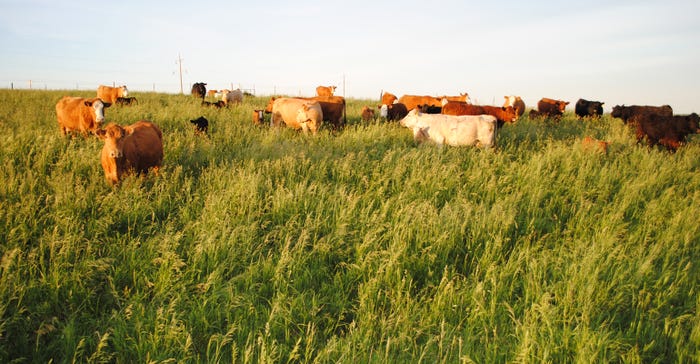
Mineral feeding can be an expensive endeavor for cow-calf pairs in the pasture, so farmers don’t want to waste a single ounce of mineral if they can help it. They don’t want to spend an extra penny on mineral either, above what is necessary to meet the nutrient requirements of the cattle.
Scott Ruzicka, account manager for Suther Feeds Inc. of Verdigre, Neb., knows that. Speaking at the recent 83rd annual Sandhills Cattle Association (SCA) meeting in Atkinson, Ruzicka explained how mineral feeding works and talked about some of the common mistakes made in mineral feeding that cost producers money.
Here are five common mistakes or misconceptions and what it takes to fix them:
1. Mineral intake math and feedout rate. “Even though both of these are the same topic, and the math is the same, the perception is different,” Ruzicka says. For instance, intake for a 4-ounce mineral is 200 cows per bag per day, but if you add a calf to the equation, feeding 5 ounces per day now amounts to 160 pairs for a bag per day of mineral.
“The feedout rate is exactly the same, but the difference is when the mineral is delivered to the pastures,” Ruzicka says. “Real life impacts the feedout rate. Rain, mud, haying, baseball, volleyball and county fair time are all examples of real-life impacts.”
A ton of mineral fed to 200 cows will last 40 days, but if you add a nursing calf and have 200 cow-calf pairs, that same ton will only last 32 days. “We all do a good job of putting out mineral and looking at intakes, but hardly ever look at feedout,” Ruzicka says. “Having a good idea of when the ton of mineral should be running out helps to keep track of our intakes. Remember, the best mineral in the world does no good in the bag in the shed.”
2. Cheaper is better. This statement is not necessarily true, but producers tend to follow this concept. “With the cost of inputs this year, it is very important to invest the mineral dollars where we get the best return,” Ruzicka explains. A few facts help to illustrate this point.
“Did you know that green growing grass can provide 40 to 50 grams of phosphorus a day to the cow?” Ruzicka says. “A lactating beef cow needs just 30 to 35 grams of phosphorus a day.” Could you feed a 4% phosphorus mineral versus an 8% phosphorus mineral?
“Consulting with a nutrition professional can save much more than it may cost,” Ruzicka suggests. “Matching mineral to the cow’s nutritional requirements and stage of production is key, so is less cost the best cost?”
A cow’s requirements minus what’s available equals what needs to be supplied, Ruzicka says. “That’s best cost,” he adds.
3. Salt requirements. Cattle have a daily requirement for salt, and cows eat mineral to meet their salt requirements. “Minerals use salt to both encourage intake and, at the same time, limit intakes to manage overconsumption,” Ruzicka says. “If salt is needed to manage consumption, always mix it with the mineral to ensure that the cattle consume both the additional salt and the mineral. Don’t separate the two sources of salt.”
4. Start sooner. While producers generally do a good job of supplying mineral to their cows, Ruzicka says, the key to any mineral program is providing the right product at the right time. “Consistently having a mineral program available that meets the requirements and stage of production and balances the diet prevents production issues,” he says. “Playing catch-up is often times costly and can have a negative impact on production, so plan ahead as requirements and diets change.”
5. Feed additives. Ruzicka says that you can make money by feeding mineral. “Properly placed and targeted additives will nearly always return more than they cost, and often return more than the entire mineral program,” he notes.
Offering an example, he says that LS201, a probiotic that can be included in minerals, will improve the feed efficiency in cows by 6% to 10% and increase gains in younger cattle by 0.10 to 0.15 pounds per day.
The additive costs less than $0.02 per day, and at $1.75-per-pound calf prices, it yields a $0.22 return. (0.125 pounds of daily gain x $1.75 value per pound = $0.22). The net is $0.20 in your pocket, Ruzicka says.
“In cows, LS201 can have the same caloric effect as feeding 2 pounds of cubes,” he says. “If cubes cost $0.20 per pound, that is a $0.40-per-day savings on an investment of $0.02. Many additives offer positive returns when used with the right product at the right time.”
SCA convention
The annual SCA meeting included talks from the Nebraska Brand Committee, Nebraska Department of Agriculture, and feature presentations from Amanda Radke and Rob Sharkey. The meeting offered a morning tour of Cottonwood Feeders, a popular trade show, a regular business meeting, a scholarship benefit auction, a Pen of Three contest and a dance.
Check out the photo gallery of scenes from the SCA meeting. Learn more about SCA at sandhillscattle.com. Contact Ruzicka at [email protected].
About the Author(s)
You May Also Like






